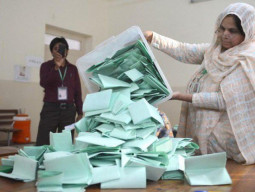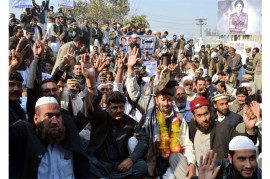
It was the year of democratic under takings – Khyber-Pakhtunkhwa saw the largest ever local government elections in 2015. That being said, 2016 has to be the year of implementation as the year that passed left a lot to be desired as far as establishing systems for local governance go.
According to a senior official of the Local Government and Rural Development (LG&RD) department, “The system is near completion and will start service delivery; give results in the coming year.”
Desk space
Requesting anonymity, the official said the delay in making the set-up completely functional made it impossible for elected councillors and nazims to do their job efficiently, forcing them to take to the streets. “Their demands for offices were genuine because they need a place to sit and hold meetings.” He added, “We didn’t find it difficult to arrange offices for town, tehsil and district councils because they had been already built by the previous government. However, we are facing problems arranging offices for village and neighbourhood councils; there are 3,501 of those.”
He shared the chief minister has given approval for renting offices for village councils. The official added the system will start showing fruit since most of the district and tehsil councils have passed their budgets.
A day of thousands
More than 84,000 candidates contested 41,762 seats across the province in 2015. There were irregularities reported on polling day and the ruling party, Pakistan Tehreek-e-Insaf, was accused by the opposition of using government machinery in its favour.
The new LG set-up comprises three tiers: district councils, town/tehsil councils and village/neighbourhood councils. The provincial government allocated Rs42 billion (30%) of the annual developmental funds for the local bodies in its budget for FY2015-16, a step towards the realisation of its promise to devolve powers to the grass roots.
PTI grabbed a majority of the seats at the district-level where polls were held on a party-basis. It has a stronghold in nine districts while its partner Jamaat-e-Islami has nazims in four districts. Pakistan Muslim League-Nawaz has three district nazims while Pakistan Peoples Party and Awami National Party secured seats in two districts.
The four months and protests
The election process stretched from May 30 to November. However, the provincial government took its time to issue the rules of business which were essential for the functioning of the three-tier government.
This prompted protests as well until the rules of business were finally rolled out in November. However, demonstrations continued as elected representatives did not approve the way power was devolved. Protesters accused the PTI-led government of deliberately delaying the formalising the rules of business and limiting their powers by giving too much control to the provincial government.
Unlike the previous LG system of 2001, the current system gives more power to the councils and not to individuals, a thing which bothered the protesters. Councillors want their own offices, which many still do not have. The government released half the development funds allocated for the three-tiers. The rest of the budget and salaries for nazims and naib nazims remain in limbo.
Regardless of its apparent shortcomings, many people call the LG elections a nursery for growing future politicians as people who never had thought of contesting ended up as councillors and nazims. Almost each street of the province had a candidate lobbying for votes, and people who never thought of voting, made their way to polling stations with fresh determination.
Published in The Express Tribune, January 1st, 2016.



























1714129906-0/Clint-Eastwood-(1)1714129906-0-270x192.webp)






COMMENTS
Comments are moderated and generally will be posted if they are on-topic and not abusive.
For more information, please see our Comments FAQ